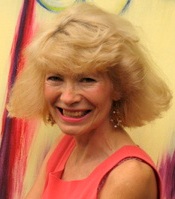Vassily Kandinsky, often considered to be the father of non-objective art, and Alexander Scriabin, 20th c. composer, both shared a faculty known as synesthesia. The stimulation of one sense evokes a response by another sense as well. Chromosthesia, in particular, occurs when sounds stimulate visions. Countless artists and musicians experience this phenomenon, which can greatly enhance life in general. Several websites focusing on this phenomenon can easily be found on the internet, and hundreds of related articles can be accessed through databases and indices.
For people who experience chromosthesia, sounds can evoke a correlating visual equivalent in the mind's eye. For me in particular this relationship manifests as a time-based complex of shapes, colors, lines and textures moving in 3-dimensional space. In a recent collaboration with the Bloomington, Indiana, Symphony Orchestra, I created a series of paintings representing Tchaikowsky's 5th Symphony, as well as the Red Cape Tango by Michael Daugherty. Each painting derives from discrete segments of the music. See : Visual Sound Music Paintings.
Many artists have attempted to establish relationships between music and art. In the early 20th c. Stanton Macdonald-Wright and Morgan Russell developed a “method of painting based on color scales that were, they believed, analogous to musical scales. Just as Western music has a twelve-tone system, so the conventional color wheel has twelve colors. In music, it is the intervals (spaces) between that establish the harmony of a chord and the character of a scale, and Macdonald-Wright and Russell believed that intervals between color could be established in the same way” (from Exhibition flyer for North Carolina Museum of Art by Will South, 2001).
The association of color with sound has a long history. Ancient Tantric thought stated that “at the vibratory level, sound creates light, for light is sound at a particular frequency... Every colour has its life-sound and in turn every sound has its form-colour” (from Mookerjee, A. Tantra Art, Paris: Ravi Kumar, 1971, p. 19).
*********************************************************************************************************************
Those of you who experience chromosthesia can tap into this resource as a source of inspiration to produce a work of art. Those of you without this particular faculty can learn to derive artistic impetus from the sound and feeling of music. You can use emotion as the interface between music and art, letting the feeling of the music inspire aesthetic choices, such as color, shape, line value, and texture.
*********************************************************************************************************************
VOCABULARY SIMILARITIES AND CONCEPTS SHARED BETWEEN ART AND MUSIC ARE NUMEROUS. SOME COMMON MUSICAL TERMS INCLUDE:
Rhythm: Flow of music through time; the pattern of durations of notes and silences in music.
Tone: Sound that has a definite pitch, or frequency.
Tone color (timbre): Quality of sound that distinguished one instrument or voice from another.
Consonance: Tone combination that is stable and restful.
Dissonance: Tone combination that is unstable and tense.
Impressionism: Musical style (flourished 1890-1920) which stresses tone color, atmosphere, and fluidity, typical of Debussy.
Expressionism: Musical style stressing intense, subjective emotion and harsh dissonance, typical of German and Austrian music of the early twentieth century.
Climax: Highest tone or emotional focal point in a melody or a larger musical composition.
Form: Organization of musical ideas in time.
Key: (tonality): Central note, scale, and chord within a piece, in relationship to which all other tones in the composition are heard.
Legato: Smooth, connected manner of performing a melody.
Staccato: Short, detached manner of performing a melody.
Style: Characteristic way of using melody, rhythm, tone color, dynamics, harmony, texture, and form in music.
Musical texture: How many layers of sound are heard at once, what kinds of layers they are, and how they are related to each other.
Motive: Fragment of a theme, or short musical idea which is developed within a composition.
Accent: Emphasis of a note, which may result from its being louder (dynamic accent), or high in pitch than the notes near it.
Word painting: Musical representation of specific poetic images—for example, a falling melodic line to accompany the word descending—often found in Renaissance and baroque music.
We speak of high notes, low notes, soft sounds, sharp sounds, etc. The language describes seemingly visual phenomena. Music can also conjure certain feelings in us, as can a work of visual art.
---from Oehmich, Projects, Exercises and Theory: "Synesthesia, Music and Art", 2005 edition.
Elaine J. Oehmich, M.F.A.
Elaine J. Oehmich, M.F.A.
Copyrighted by Elaine J. Oehmich 2010. All Rights Reserved.

SYNESTHESIA, MUSIC AND ART
by
Elaine J. Oehmich, M.F.A.